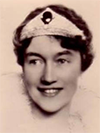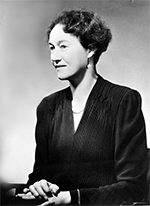Charlotte: Grand Duchess of Luxembourg
Charlotte was Grand Duchess of Luxembourg for more than four decades in the 20th Century, significantly ruling during the Second World War. 
She was born on Jan. 23, 1896, in Berg Castle, in Colmar-Berg. Her father was the eventual William IV, and her mother was Marie Anne of Portugal. She was 9 when her grandfather, the reigning Grand Duke, died, and her father took over rule of the grand duchy. A mere five years later, he died, and her older sister, Marie-Adélaide, took over. She was 17. Their mother served as regent for a few weeks, until the Grand Duchess turned 18; then, she ruled in her own right. Charlotte grew up as the heir apparent, watching how her sister got personally involved with the goings-on in government, unlike some of her predecessors. Like Belgium, Luxembourg prided itself on its neutrality and did not join the entangling alliances that helped precipitate World War I. However, as with Belgium, Germany ignored Luxembourg's neutrality in its westward march at the outset of the war, professing a need to protect the railroads. Marie-Adélaide and her government screamed internationally in protest but did not attempt to oust the occupying army using force. Luxembourg had rather a small armed force, anyway, and did little to contribute to the war effort on the battlefields. The one exception was in the Red Cross tents, where the grand duchess herself led health and relief efforts. She also angered leaders within her government by, in order to bypass gridlock, dissolving the Chamber of Deputies and scheduling new elections, in 1915. As the war wound down, calls for Marie-Adélaide to step aside became more frequent. She had dismissed them initially as political maneuvering but, in the face of fierce criticism internally and internationally after the end of the war, she decided to abdicate. She stepped aside on Jan. 14, 1919, and Charlotte took over. The new grand duchess came with a new constitution, adopted by referendum later that year. A primary feature of the new governmental blueprint was a steep reduction in the powers of the monarch. 
Germany ignored Luxembourg's wish for neutrality again in 1940, invading on May 9 and quickly overwhelming the grand duchy's ability to stop the advance. Charlotte and her government leaders set up a government in exile in France and then, after the fall of that country, moved to Portugal. Charlotte ended up in London, from where she used radio broadcasts to encourage her people to keep the faith. She later traveled to Canada and the United States. Charlotte had married Prince Felix of Bourbon-Parma on Nov. 6, 1919. They had six children: Jean (1921), Elizabeth (1922), Marie Adelaide (1924), Marie Gabrielle (1925), Charles (1927), and Alix (1929). Those children went with their family across the Atlantic and continued their studies in Montreal during the war. Jean, the oldest child, volunteered for the Irish Guards. Allied troops liberated Luxembourg in September 1944. The royal family returned and, together with the government leaders, spent many years rebuilding their country. Charlotte presided over an era of increased cooperation within Europe, punctuated by the establishment of the Benelux Customs Union, the European Economic Community, and NATO. Charlotte gradually delegated most of her ducal duties to her son, Jean, who had returned home after the war. On Nov. 12, 1964, when she was 68, she abdicated; at that point, Jean became Grand Duke. Charlotte retired to a largely private life. Her husband, Felix, died in 1970. She contracted cancer, from which she died, on July 9, 1985, in Schloss Fischbach. |
|
Social Studies for Kids
copyright 2002–2025
David White




